AP calculus AB general info
1/86
Earn XP
Name | Mastery | Learn | Test | Matching | Spaced |
|---|
No study sessions yet.
87 Terms
area between curves
a∫b(top-bottom)dx
or:
a∫b(right-left)dy
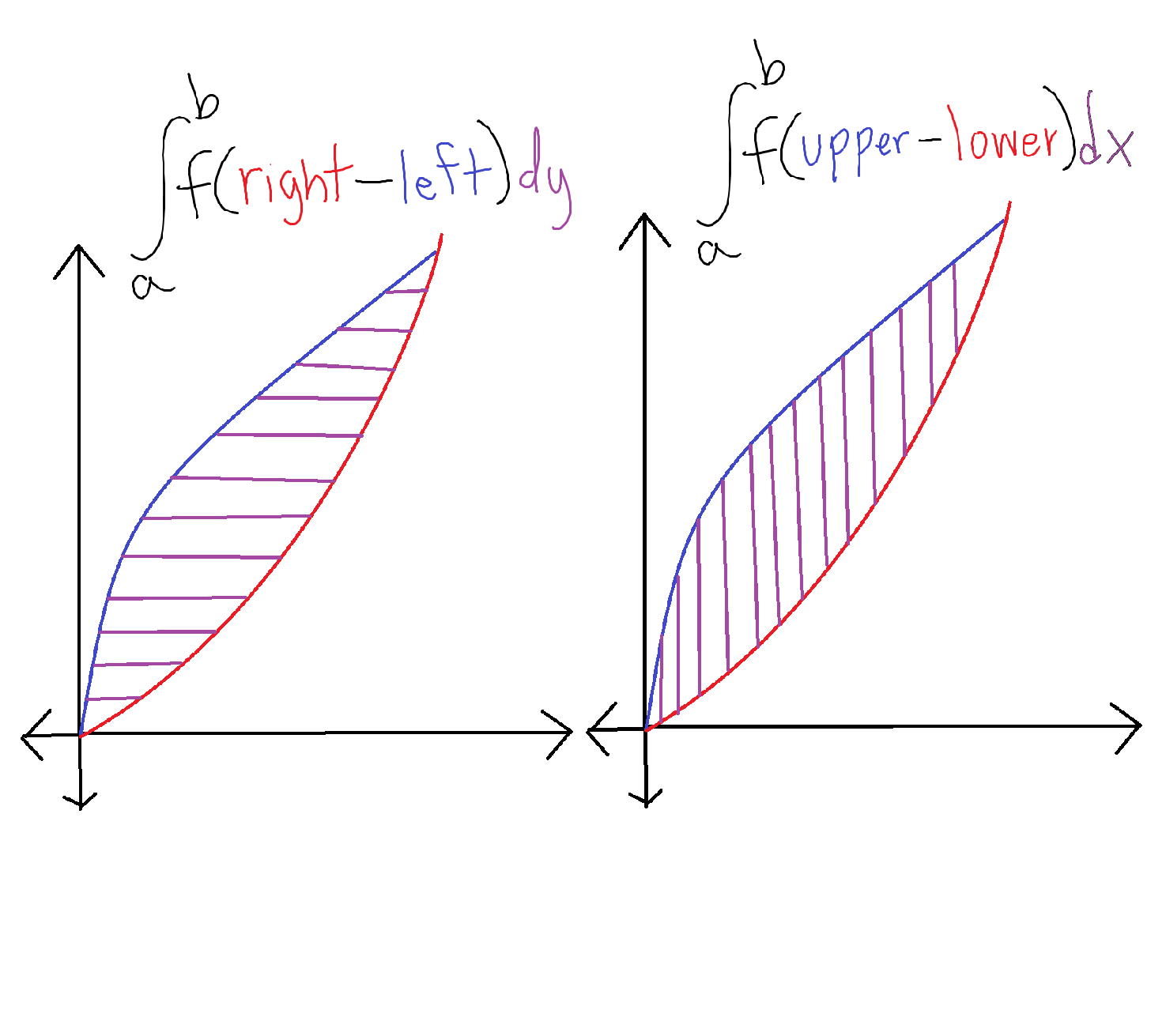
volume of a revolution
πa∫b[R(x)]2dx
where R(x) is the radius of the function (usually the area between two curves)
![<p><span>π</span><sub>a</sub>∫<sup>b</sup>[R(x)]<sup>2</sup>dx </p><p>where R(x) is the radius of the function (usually the area between two curves)</p>](https://knowt-user-attachments.s3.amazonaws.com/0064b143-8369-4128-b858-cdc26350d6e7.png)
volume of a revolution (washers)
πa∫b[r(outer)2-r(inner)2]dx
where r is the radius function
![<p>π<sub>a</sub>∫<sup>b</sup>[r(outer)<sup>2</sup>-r(inner)<sup>2</sup>]dx </p><p>where r is the radius function</p>](https://knowt-user-attachments.s3.amazonaws.com/9fa9a014-80d8-43e0-865f-ffc2ad07ba05.png)
volume by cross section
a∫b[A(x)]dx
where A(x) is the are for the shape of the cross section
![<p><sub>a</sub>∫<sup>b</sup>[A(x)]dx</p><p>where A(x) is the are for the shape of the cross section</p>](https://knowt-user-attachments.s3.amazonaws.com/f7aff361-5862-4e6f-88b4-0267230e5c5f.png)
∫(1/x)dx
ln|x| + C
∫exdx
ex + C
∫csc(x)cot(x)dx
-csc(x) + C
∫sec(x)tan(x)dx
sec(x) + C
∫csc2(x)dx
-cot(x) + C
∫sec2(x)dx
tan(x) + C
∫sin(x)dx
-cos(x) + C
∫cos(x)dx
sin(x) + C
∫xndx
(xn+1)/(n+1) + C
Fundemental Theorum of Calculus (Part 1)
a∫bf(x)dx = F(b) - F(a)
where F’(x) = f(x)
Fundemental Theorum of Calculus (Part 2)
d/dxa∫xf(t)dt = f(x)
and
d/dxa∫uf(t )dt = f(u) * u’
average value of a function
(1/(b-a))a∫bf(x)dx
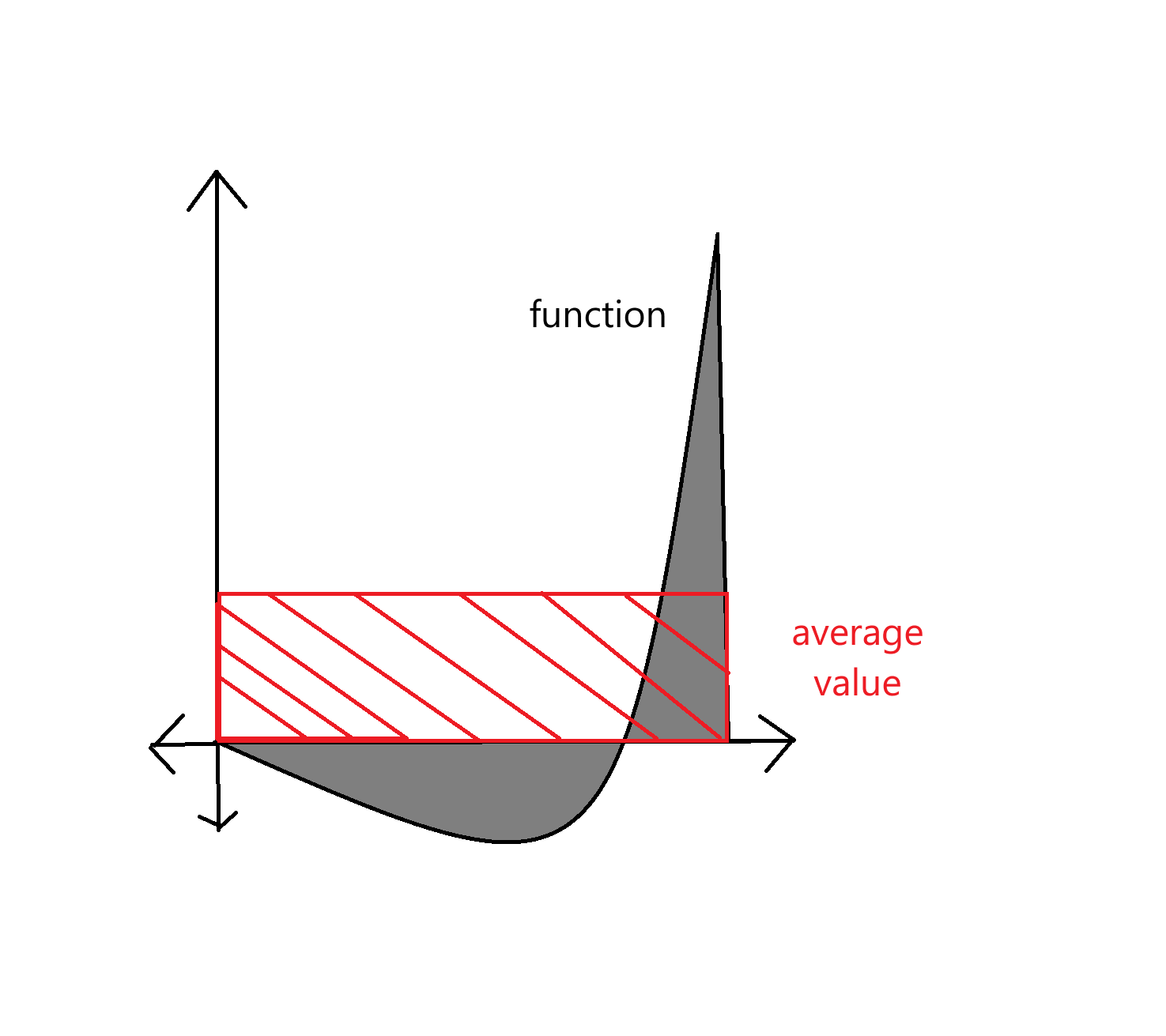
trapezoidal Reiman sum
a∫bf(x)dx over n sumbintervals = [(b-a)/2n](f(xn) + f(xn-1)…)
 + f(x<sub>n-1</sub>)…)</p>](https://knowt-user-attachments.s3.amazonaws.com/ed15c314-3b54-4b25-a2f0-3559bc0db619.png)
right Reiman sum
a∫bf(x)dx over n sumbintervals = [(b-a)/n][f(x1) + f(x2)… + f(xn)]
![<p><sub>a</sub>∫<sup>b</sup>f(x)dx over n sumbintervals = [(b-a)/n][f(x<sub>1</sub>) + f(x<sub>2</sub>)… + f(x<sub>n</sub>)]</p>](https://knowt-user-attachments.s3.amazonaws.com/0c092451-fb1e-48b2-a1c9-f59d3c0b966c.png)
left Reiman sum
a∫bf(x)dx over n sumbintervals = [(b-a)/n][f(x0) + f(x1)… + f(xn-1)]
![<p><sub>a</sub>∫<sup>b</sup>f(x)dx over n sumbintervals = [(b-a)/n][f(x<sub>0</sub>) + f(x<sub>1</sub>)… + f(x<sub>n-1</sub>)]</p>](https://knowt-user-attachments.s3.amazonaws.com/c3e43b8e-30d8-4c86-9acd-e44b9e1a499f.png)
midpoint Reiman Sum
a∫bf(x)dx over n sumbintervals = [(b-a)/n][f((a+c)/2) + f((d+b)/2)…]
![<p><sub>a</sub>∫<sup>b</sup>f(x)dx over n sumbintervals = [(b-a)/n][f((a+c)/2) + f((d+b)/2)…]</p>](https://knowt-user-attachments.s3.amazonaws.com/c0a21e0f-b3f5-47cf-baee-41d4705daa28.png)
a∫bf(ax)dx
[F(ax)]/a + C
a∫af(x)dx
0
a∫bc*f(x)dx
c*a∫bf(x)dx
a∫bf(x)±g(x)dx
a∫bf(x)dx ± a∫bg(x)dx
a∫bf(x)dx + a∫cf(x)dx
a∫cf(x)dx
a∫bf(x)dx
-b∫af(x)dx
a∫b c dx
c(b-a)
a critical point on f(x)
where f’(x) = 0
or
f’(x) = DNE
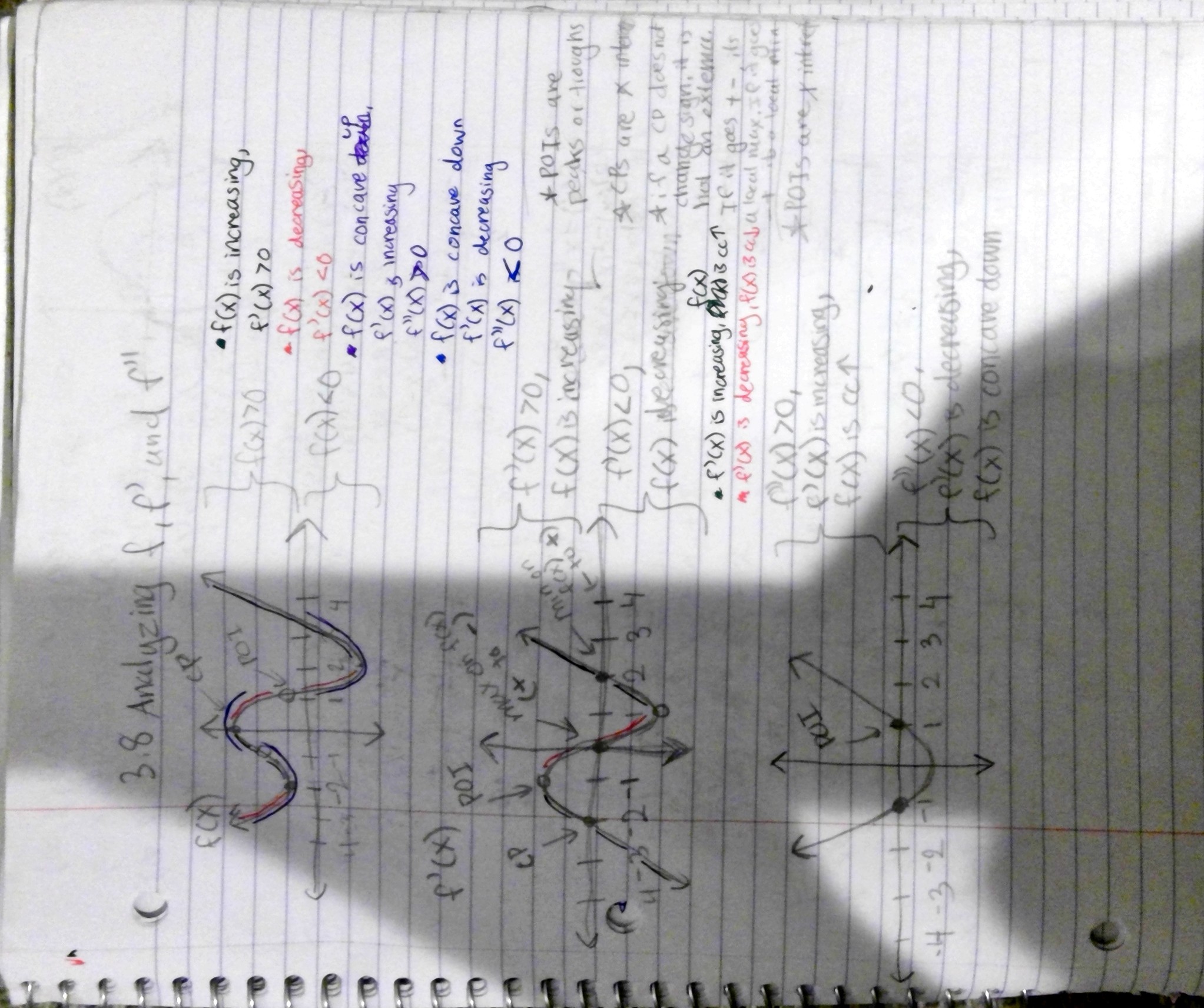
a point of inflection on f(x)
where f’’(x) = 0 or DNE
and
where f’(x) has a critical point

if f’’(x) > 0
f’(x) is increasing
and
f(x) is concave up
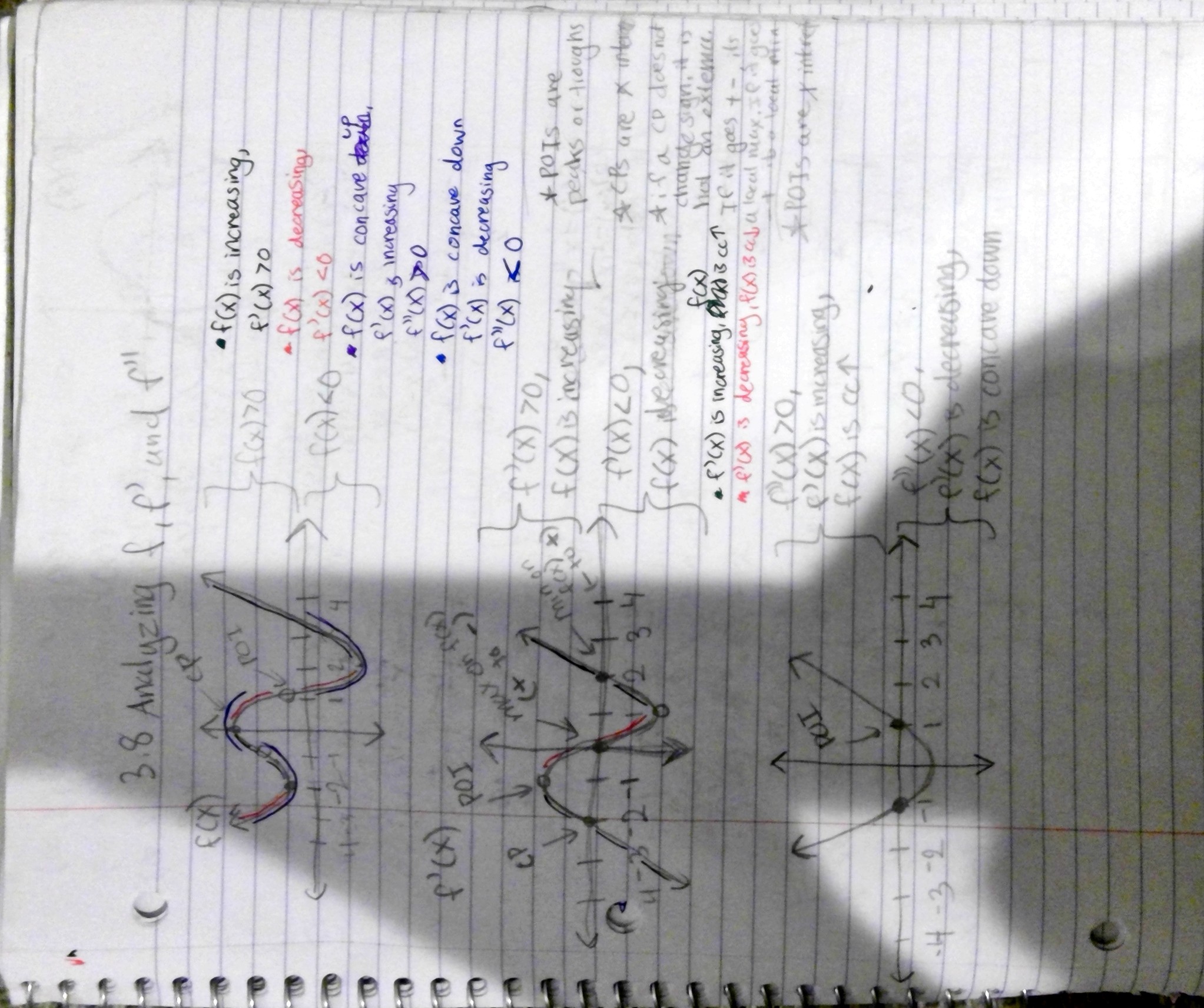
if f’’(x) < 0
f’(x) is decreasing
and
f(x) is concave down
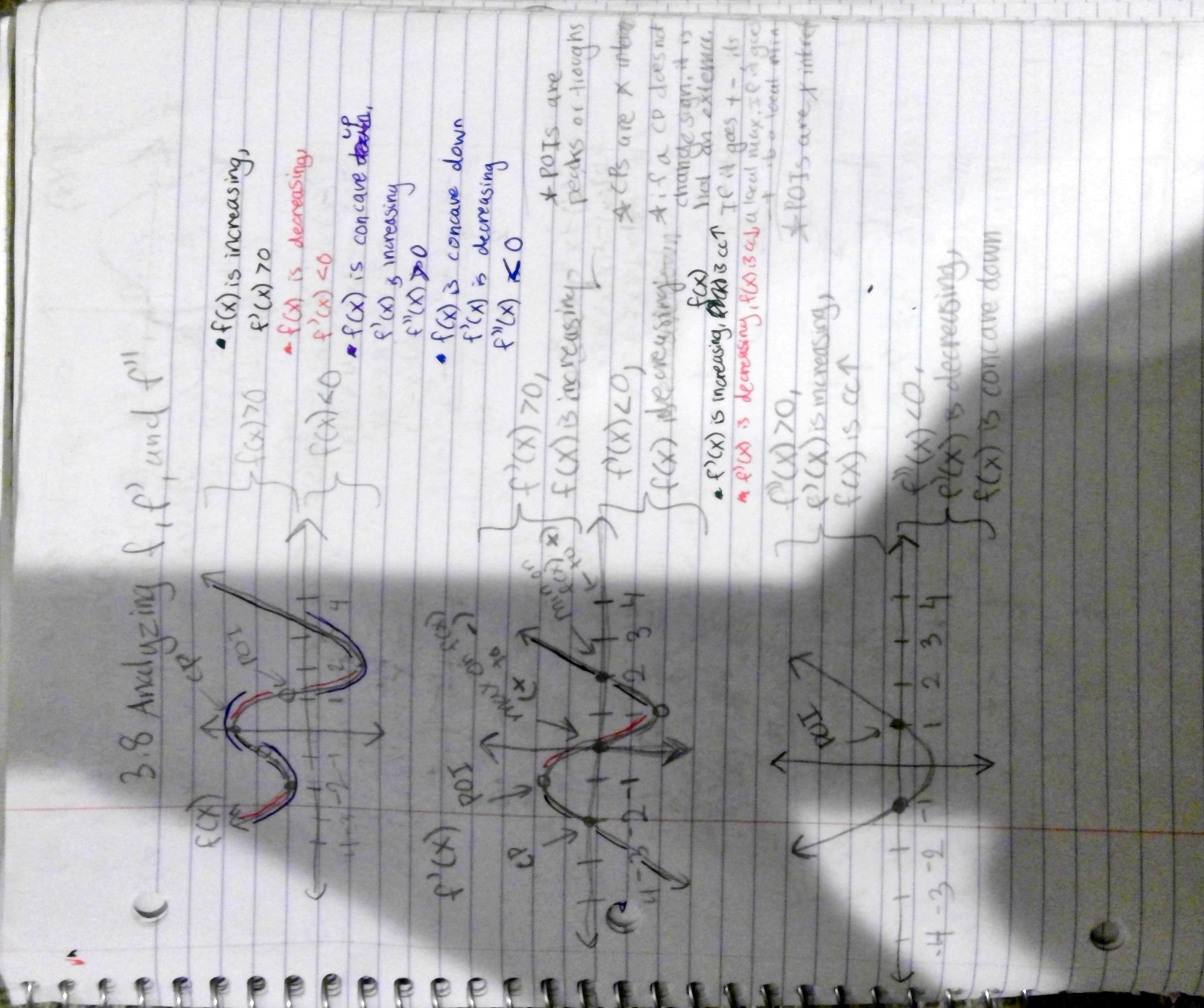
if f’(x) is decreasing
f(x) is concave down
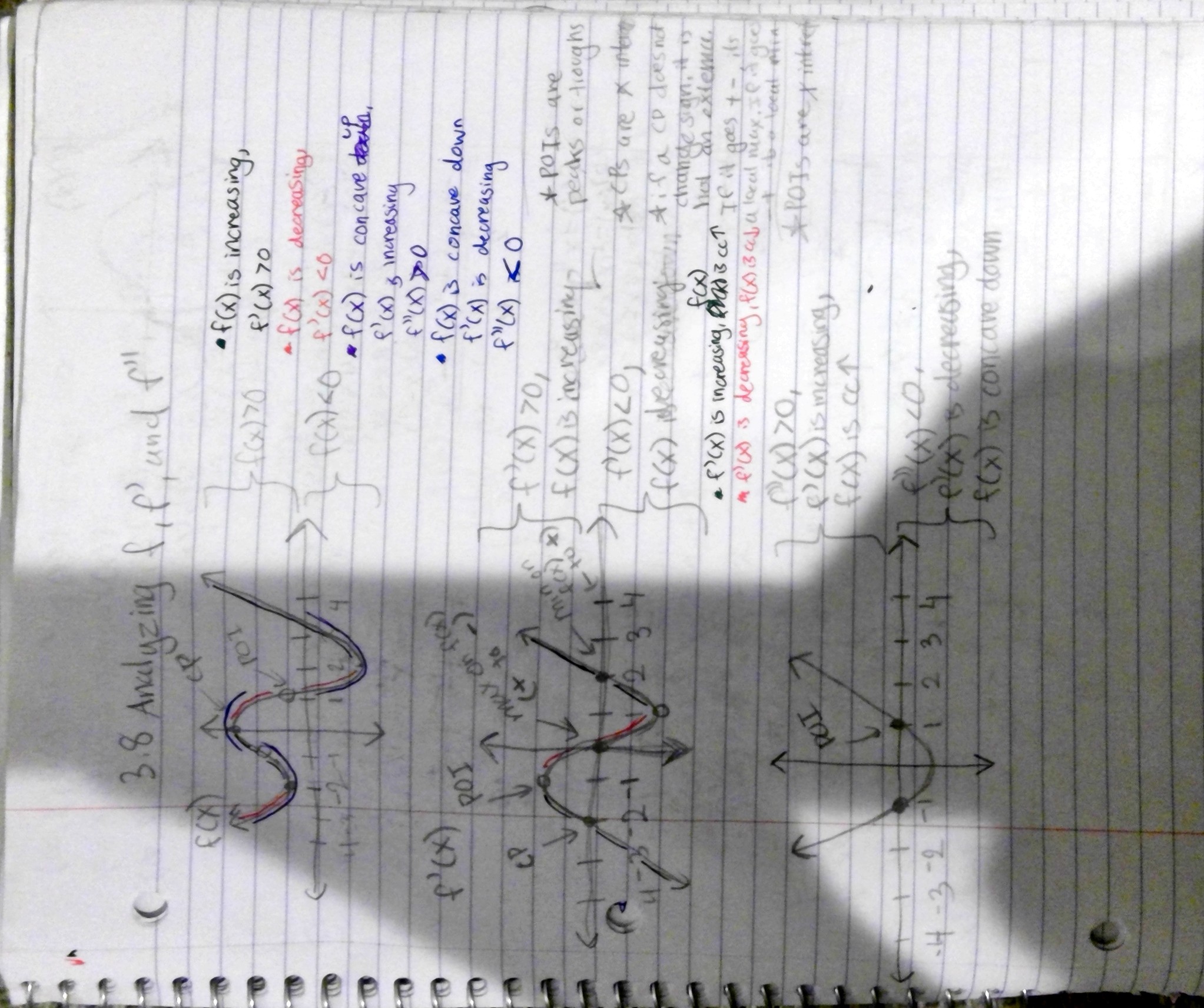
if f’(x) is increasing
f(x) is concave up
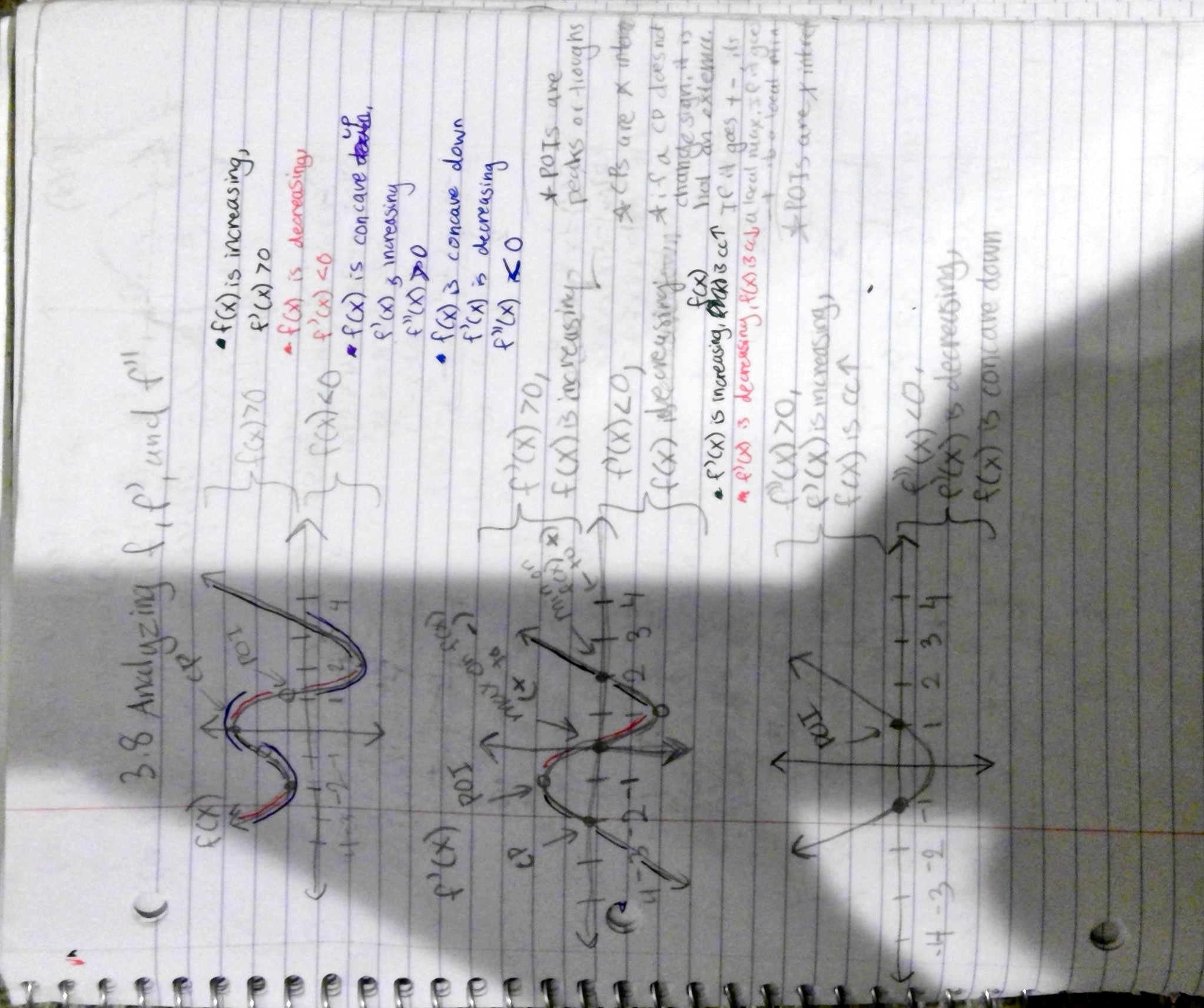
if f’(x) > 0
f(x) is increasing
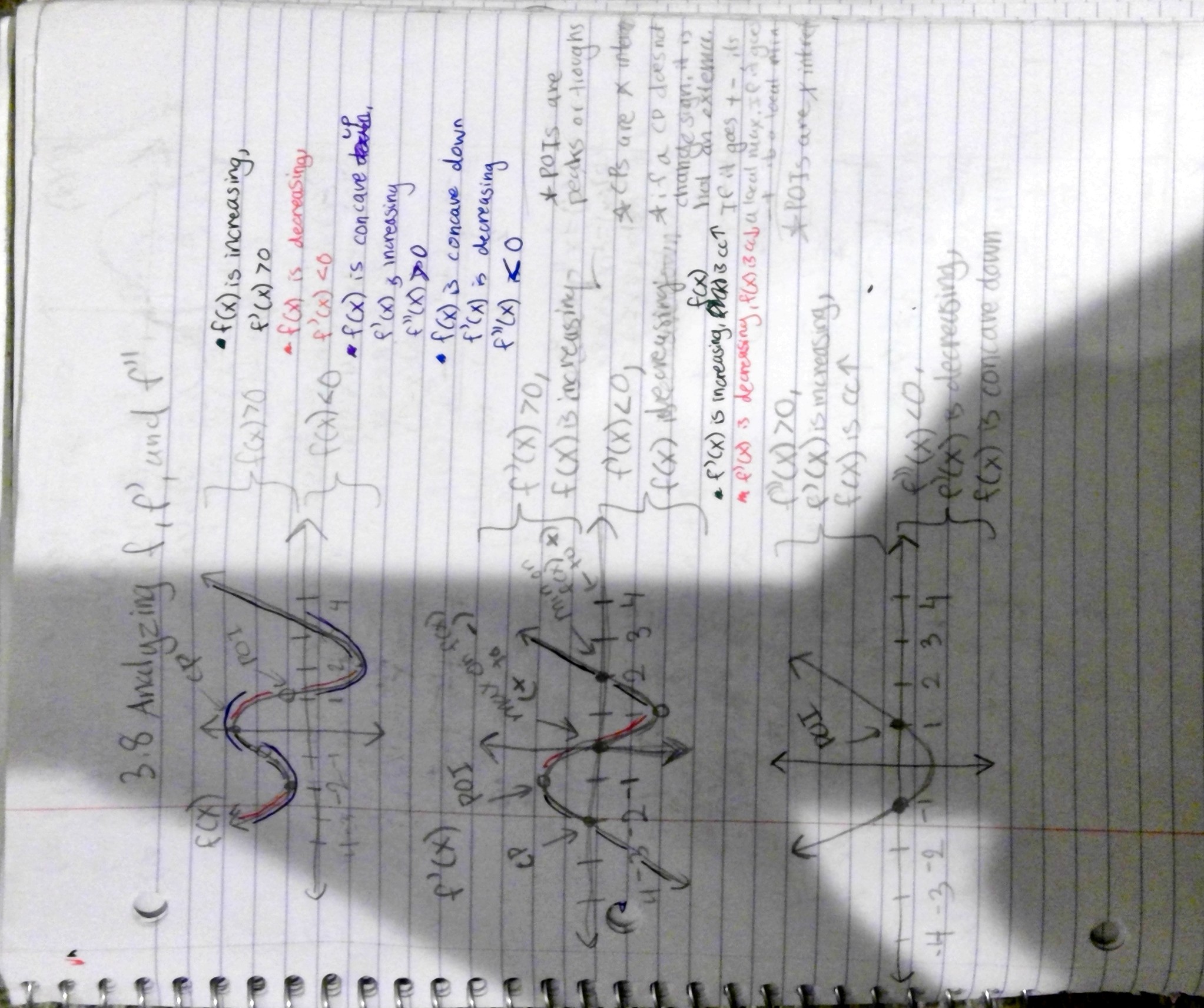
if f’(x) < 0
f(x) is decreasing
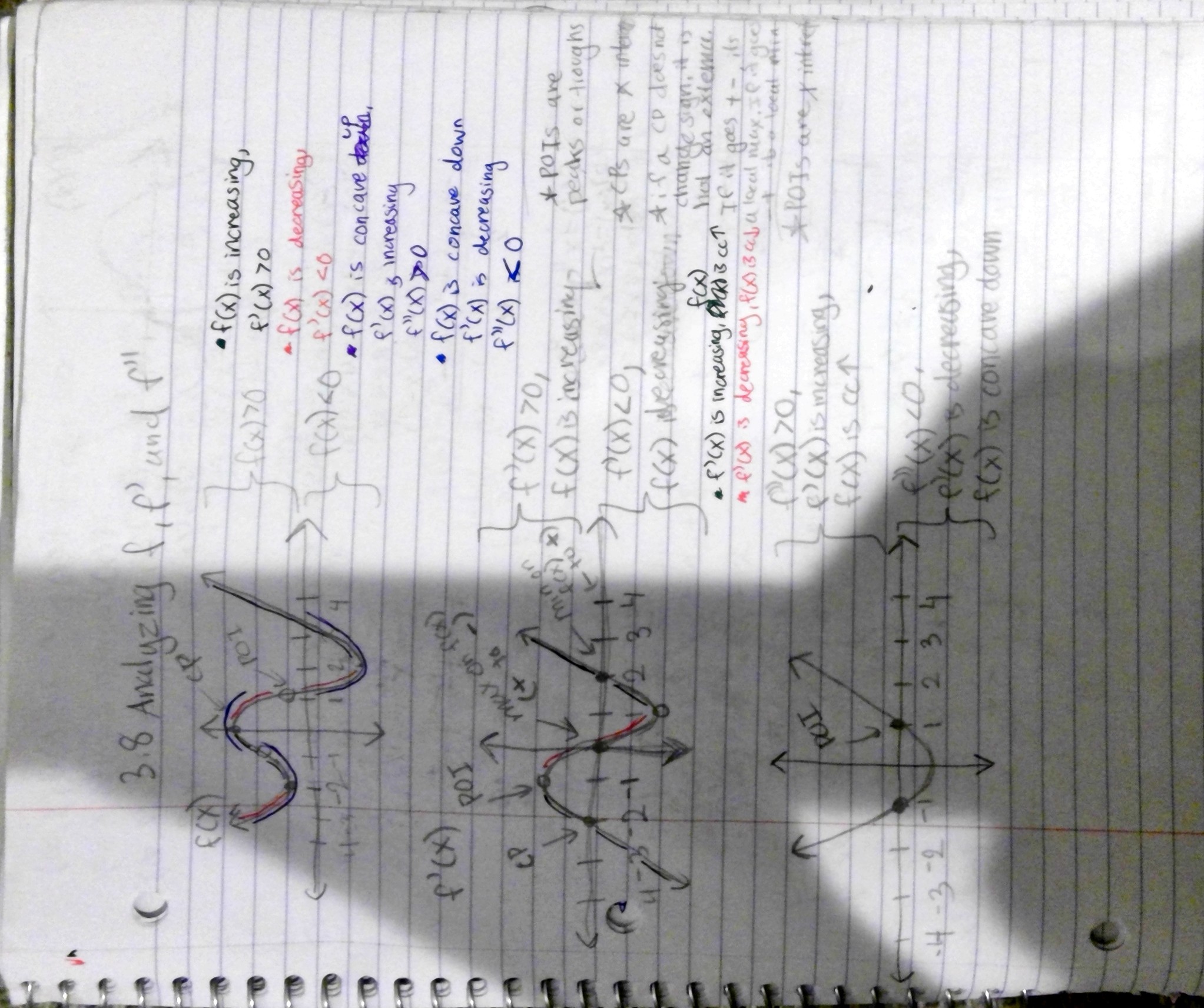
particle motion equations
position/displacement: x(t) or ∫v(t)dt
velocity: v(t) or x’(t) or ∫a(t)dt
acceleration: a(t) or v’(t) or x’’(t)
distance: ∫|v(t)|dt
a particle is slowing down
if v(t) and a(t) have opposite signs
a particle is speeding up
if v(t) and a(t) have same signs
a particle is moving toward the origin
if x(t) and v(t) have opposite signs
a particle is moving away from the origin
if x(t) and v(t) have the same sign
a local minima is where…
f’(x) crosses the x axis from negative to positive

a local maxima is where…
f’(x) crosses the x axis from positive to negative
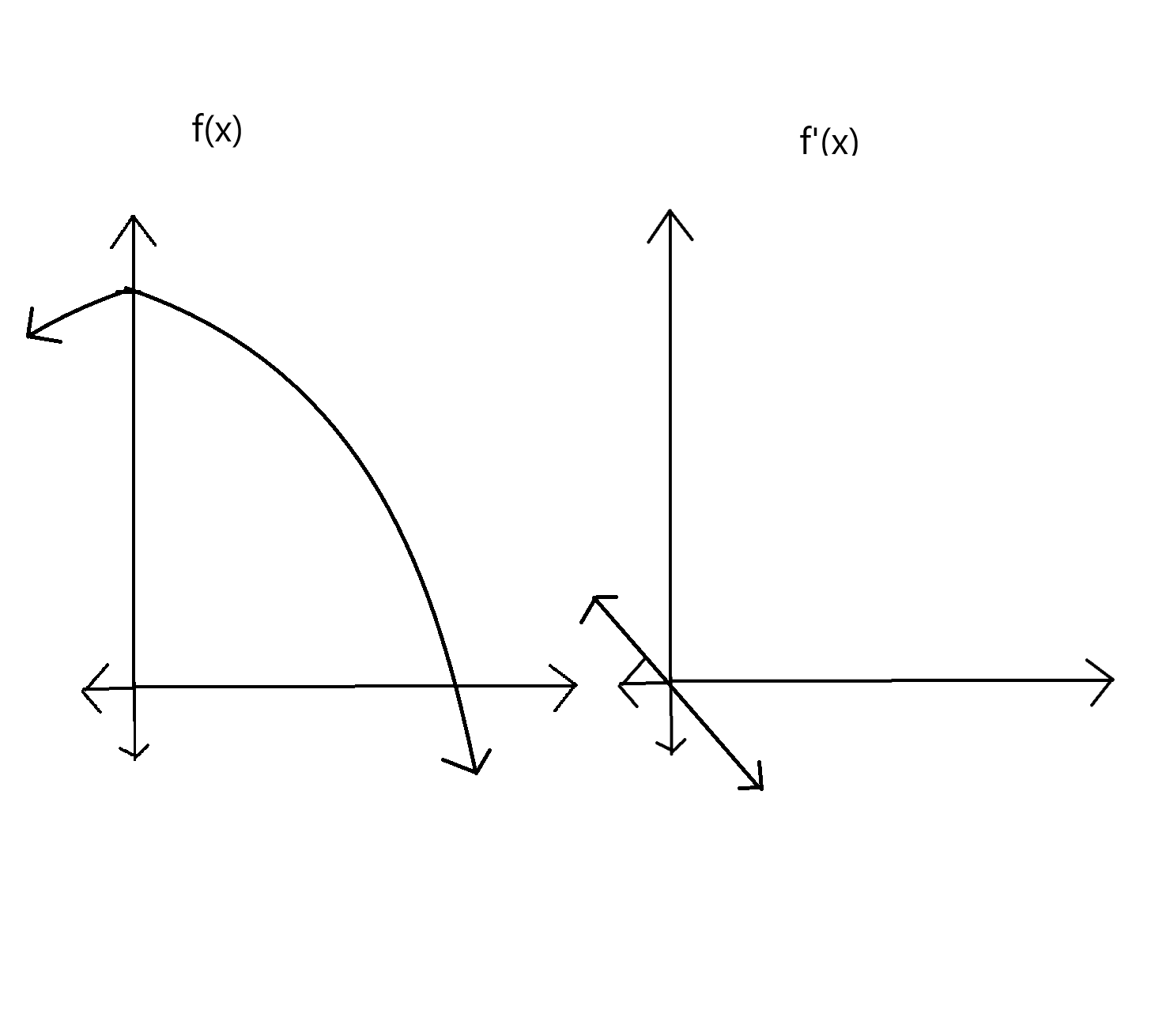
a function is changing direction when…
f’(x) changes sign
Intermediate value theorem (IVT)
If f(x) is continuous on a closed interval [a,b], then for every k ∈ (f(a), f(b)), there exists a c ∈ (a,b) such that f(c) = k.
AKA: f(x) goes through every x value between a and b and through every y value between f(a) and f(b)
![<p>If f(x) is continuous on a closed interval [a,b], then for every k <span>∈ (f(a), f(b)), there exists a c ∈ (a,b) such that f(c) = k.</span></p><p></p><p><span>AKA: f(x) goes through every x value between a and b and through every y value between f(a) and f(b)</span></p>](https://knowt-user-attachments.s3.amazonaws.com/bbda4189-7f1e-4770-8a38-1eb279061130.svg)
Mean value theorem (MVT)
If f(x) is continuous on a closed interval [a,b] and differenciable on an open interval (a,b), then there exists a c ∈ (a,b) such that f’(c) = [f(b)-f(a)]/(b-a)
AKA: there is an f’(x) on the interval (a,b) which is equal to the average rate of change between a and b
![<p>If f(x) is continuous on a closed interval [a,b] and differenciable on an open interval (a,b), then there exists a c <span>∈ (a,b) such that f’(c) = [f(b)-f(a)]/(b-a)</span></p><p></p><p><span>AKA: there is an f’(x) on the interval (a,b) which is equal to the average rate of change between a and b</span></p>](https://knowt-user-attachments.s3.amazonaws.com/7679d369-f2ac-4303-bcee-53a13129c528.jpg)
Extreme Value Theorem (EVT)
If f(x) is continuous on a closed interval [a,b], then f(x) takes on a maximum and minimum value on [a,b] and they must occur at an endpoint or critical point
*if (a,b) is an open interval, this could be true but not necessarily
![<p>If f(x) is continuous on a closed interval [a,b], then f(x) takes on a maximum and minimum value on [a,b] and they must occur at an endpoint or critical point</p><p></p><p>*if (a,b) is an open interval, this could be true but not necessarily</p>](https://knowt-user-attachments.s3.amazonaws.com/8c2f4831-c9e6-49c3-8d93-3e4ab71778ec.jpg)
differentiability on a graph
f(x) is not differentiable if f(x) is discontinuous or if it is at a corner, cusp, or vertical tangent
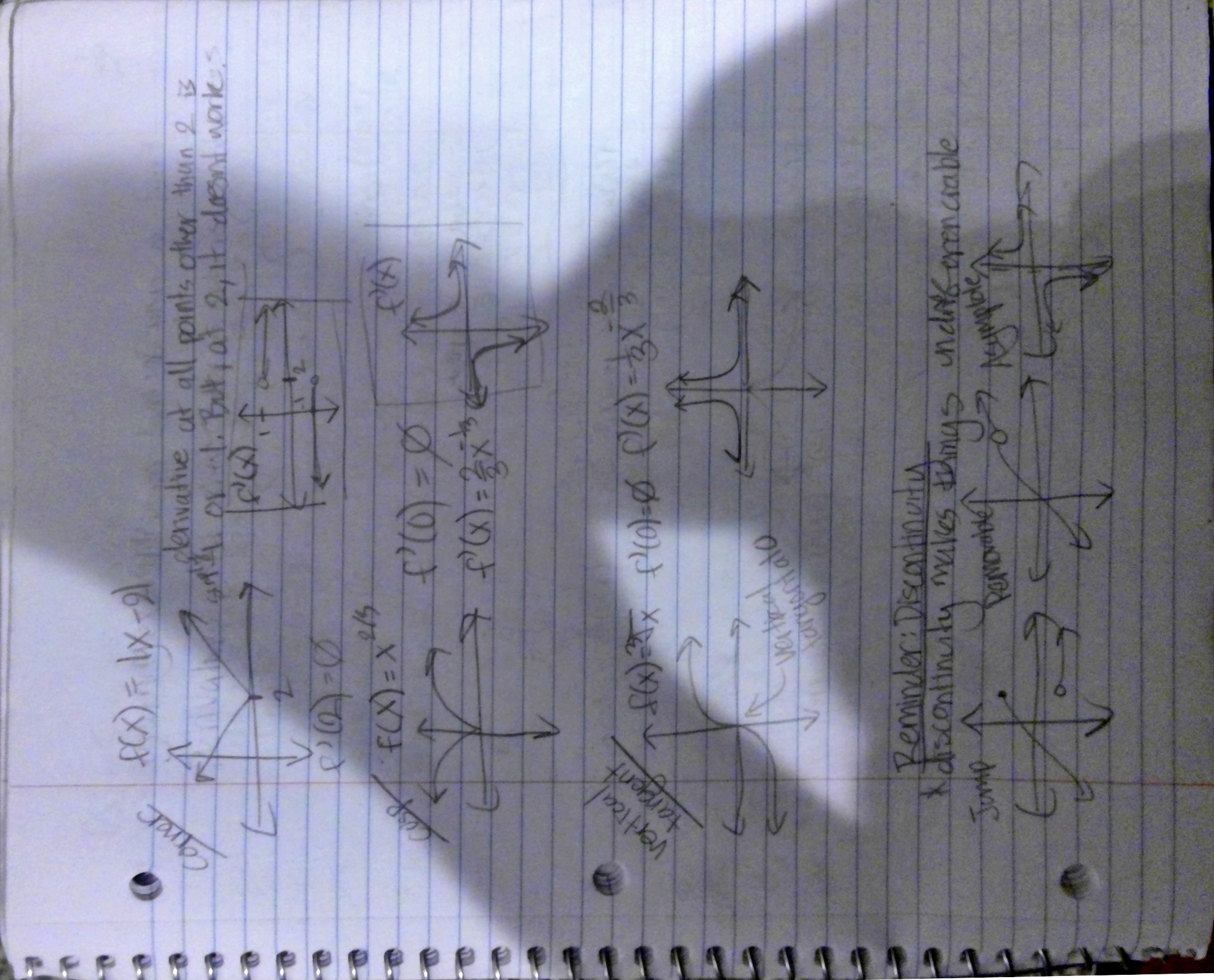
differentiability
a function is differentiable when:
1) f(x) is continuous at point c
2) lim f(x) = lim f(x)
x→ c+ x→c-
3) f(c) ≠ ∅
implicit differenciation
for f(x) = u + y where y is part of a function
f’(x) = u’ * y’
y’ = u’/f’(x)
constant multiple rule
d/dx c*f(x) = c*f’(x)
quotient rule
for f(x) = u/v,
f’(x) = (v*u’ - u*v’)/v2
sum + difference rule
d/dx(f(x) ± g(x)) = f’(x) ± g’(x)
product rule
for f(x) = u*v
f’(x) = v*u’ + u*v’
chain rule
d/dx f(g(x)) = f’(g(x)) * g’(x)
power rule
for f(x) = xn, f’(x) = nxn-1
g’(x) where g(x) = f-1(x)
1/f’(g(x))
d/dx logbu
u’/(u*lnb)
d/dx eu
eu * u’
d/dx ex
ex
d/dx ax
ax * lna
d/dx au
au * lna * u’
d/dx lnu
u’/u
d/dx logbx
1/xlnb
d/dx lnx
1/x
d/dx sinx
cosx
d/dx cosx
-sinx
d/dx cotx
-csc2x
d/dx secx
sec(x)tan(x)
d/dx cscx
-csc(x)cot(x)
d/dx tanx
sec2x
d/dx arccsc(x)
-1/(|x|√(x2-1))
d/dx arcsec(x)
1/(|x|√(x2-1))
d/dx arctan(x)
1/(1+x2)
d/dx arccot(x)
-1/(1+x2)
d/dx arccos(x)
-1/√(1-x2)
d/dx arcsin(x)
1/√(1-x2)
d/dx C
0
lim sin(ax)/bx
x→0
a/b
lim sin(x)/x
x →0
1
lim (1-cosx)/x
x →0
0
first limit definition of a derivative
lim (f(x+h) - f(x))/h
h → 0
second limit definition of a derivative
lim (f(x)-f(c))/(x-c)
x → c
l’hôpital’s rule
if lim f(x)/g(x) = 0/0 or ∞/∞ and f(x) and g(x) are differenciable on the interval (a,b) contianing c and g’(x) ≠ 0 for all x in (a,b) except c, then
lim f(x)/g(x) = f’(x)/g’(x)
x → c
to find lim f(x)
x→c
1) plug in c
if you get an indeterminate: factor, multiply by a conjugate, or use l’hôpital’s rule
if you get a value over 0 (#/0), you have an asymptote. Plug in a number very close to c to figure out what kind.
if you get a normal value, that’s the limit!
to find lim f(x)
x→∞
look at end behavior
for polynomials:
even degree + positive = ∞ (and vise versa)
odd degree + positive = ∞ as x goes to the right (and vise versa)
for exponential functions:
ex and ax trend towards infinity on the right and 0 on the left
e-x and a-x are the opposite
for rational functions:
if numerator>denominator, ∞
if denominator> numerator, 0
for other functions (ex: lnx/ex):
treat it like a rational function. If the numerator grows faster, it’s ∞, if the denominator grows faster, it’s 0.
continuity
a function is continuous if:
1) lim f(x) exists
x→c
2) f(c) exists
3) lim f(x) = f(c)
x → c
types of discontinuity
1) jump
2) removable
3) infinite discontinuity/asymptote